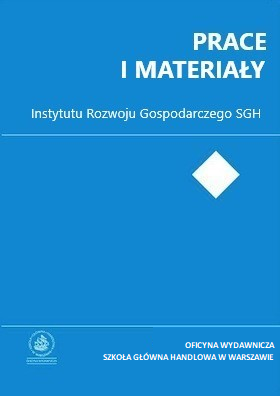Hidden Markov Models in Analysis of Results of Business Tendency Surveys
Main Article Content
Abstract
The paper considers the possibility of using the Viterbi algorithm to analyse results of the RIED WSE business surveys in the manufacturing industry.The analysis was focused on the state balances. The hidden Markov models with conditional normal distributions were applied. There were considered models with two-state and three-state Markov chains. The results were compared with the timing of turning points taken from other sources. The tested models were compared in terms of effectiveness in detecting of coming changes in economic conditions. The analysis suggests models with three-state Markov chains be used. The results also suggest that it is necessary to take into account a delay between the opinions of survey respondents and changes in economic climate. (original abstract)
Article Details
References
Abberger K., Nierhaus W., Markov-switching and the Ifo business climate: The Ifo business cycle traffic lights, „Journal of Business Cycle Measurment and Analysis”, nr 2, 2010
Adamowicz E., Dudek S., Pachucki D., Walczyk K., Wahania cykliczne w Polsce i strefie euro, „Prace i materiały Instytutu Rozwoju Gospodarczego SGH”, nr 89, Oficyna Wydawnicza SGH, Warszawa 2012
Cappé O., Moulines E., Rydén T., Inference in hidden Markov models, Springer Series in Statistics, 2005
Cleveland R. B., Cleveland W. S., McRae J. E., Terpenning I., STL: A seasonal-trend decomposition procedure based on loess, „Journal of Official Statistics”, vol. 6, 1990
Drozdowicz-Bieć M., Cykle i wskaźniki koniunktury, Poltext, Warszawa 2012
Drozdowicz-Bieć M., Od recesji do boomu. Wahania cykliczne polskiej gospodarki 1990-2007, w: „Koniunktura gospodarcza – 20 lat doświadczeń Instytutu Rozwoju Gospodarczego SGH”, pr. zb. pod red. E. Adamowicz, „Prace i Materiały Instytutu Rozwoju Gospodarczego SGH”, Oficyna Wydawnicza SGH, Warszawa 2008
Hamilton J. D., Time series analysis, Princeton University Press, Princeton, New Jersey 1994
Rabiner L. R., A tutorial on hidden Markov models and selected applications in speech recognition, „Proceedings of the IEEE, vol. 77, 1989
Skrzypczyński G., Wykorzystanie ukrytych modeli Markowa do wyznaczania punktów zwrotnych koniunktury na podstawie danych ankietowych, praca niepublikowana, badanie statutowe Instytut Ekonometrii SGH, Warszawa 2008
Viterbi A., Error bounds for convolutional codes and an asymptotically optimum decoding algorithm, „IEEE Transactions on Information Theory, vol. 13, 1967
